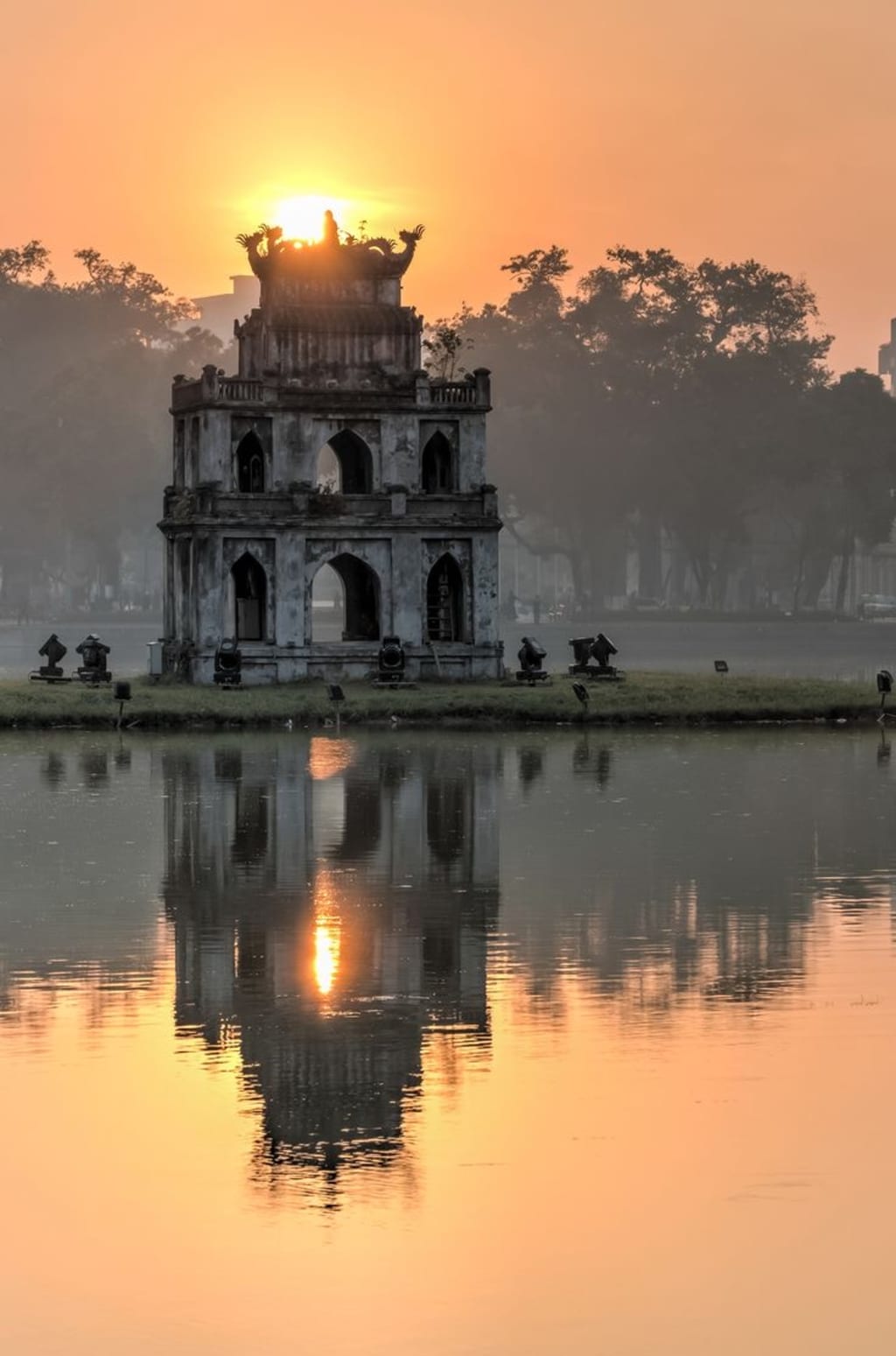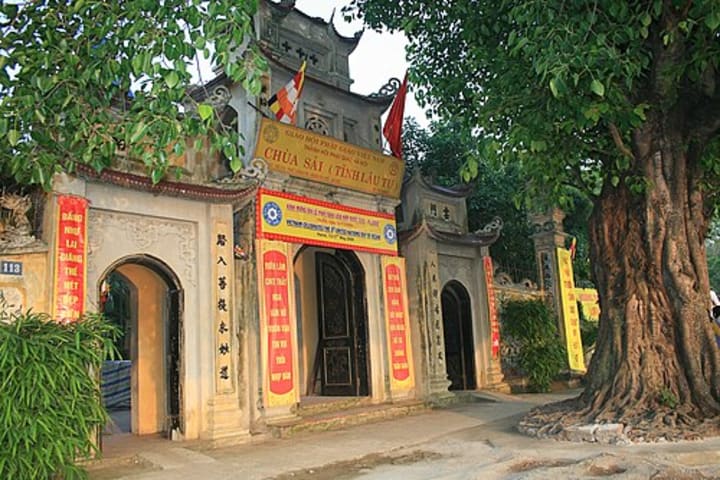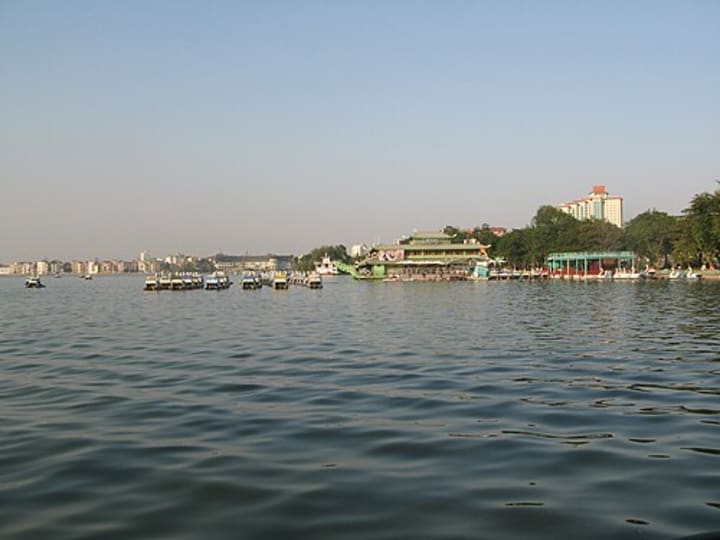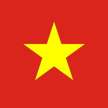About VietNam🇻🇳
Hello, my name is Minh Hoang, I come from Vietnam, I will introduce to you about a famous historical site in our country.

general
West Lake (with other historical names such as Dam Cao Cao, Kim Nguu Lake, Lang Bac, Dam Dam, Doai Ho) is the largest natural lake in Hanoi city, currently located in Tay Ho district. This is a horseshoe lake and a vestige of the old flow of the Red River. The lake has an area of more than 500 hectares with a circumference of about 14.8 km.
History
The book Tay Ho Chi records that West Lake existed during the reign of Hung King. At that time, this place was a wharf adjacent to the Red River in Lam Ap cave, so it was called Lam Ap wharf in Long Do village. During Hai Ba Trung's time, this wharf was connected to the Red River, surrounding the lake was a forest including many main types of plants such as bamboo, eagle, ironwood, reeds, sturgeon wood... along with a number of rare animals. survival. In addition, around the lake shore there are also small and medium caves. On the west bank there is Gia La Dong (now Quan La in Xuan La ward), on the east bank there is Nha Lam Dong (now Yen street). Ninh, Hoe Nhai), on the southern bank there is Binh Sa Dong (changed under the Ly Dynasty to Giap Co Xa, now in Hoan Kiem district). Residents here are very sparse, they live mainly by hunting wild animals, shrimp, crabs, fish and growing trees.
Geographically, West Lake is an exogenous lake, shaped like a basin. Historical geology has proven that West Lake is a part of the Red River.
The book Dai Viet Complete History records that in 1044, in September, the King ordered a large cage to be placed in Dam Dam (West Lake), using Champa's domestic elephant as bait to lure wild elephants into it, and the king himself came to capture it.
West Lake has long been a scenic spot. During the Ly - Tran dynasties, the kings built many palaces around the lake as places for relaxation and entertainment, such as the Thuy Hoa and Tu Hoa palaces during the Ly period, now the Ham Nguyen palace area, under the Tran dynasty, now the Tran Quoc pagoda area. Legend has it that Kim Lien Pagoda was built on the palace grounds of Princess Tu Hoa, daughter of King Ly Than Tong. To develop the funeral-hunting facility, Princess Tu Hoa brought her palace maids to the West Lake area to reclaim land, set up hamlets and establish a mulberry growing and silkworm-weaving profession for them. Camp Nghi Tam is a large estate that takes care of this.
West Lake was still explored and renovated during the Tran Dynasty. Princess Tuc Trinh, daughter of King Tran Thanh Tong (1258-1278), left the palace to the Beijing area to become Thang Long and spent money to distribute food and provide capital for poor people to make a living. 'At first, we only recruited 10 people. We saw that the garden by the river was both beautiful and convenient to travel, so we established a small hamlet in the Land of the Garden. Later, the people established a village and named it Co Nhue Vien.
During his northern trip to visit West Lake, King Thieu Tri commented: "People still say: Thang Long has many beautiful landscapes, of which West Lake is the best. Up to now it seems to be just a pond compared to West Lake [China]. that's all."
Chieu Nghi Vu Thi Ngoc Xuyen (Princess of Lord Trinh Tac) in the 17th century helped people clear up wild fields in the village area of Minh Cao - Xuan Dinh commune (now in Tay Ho District). In the past, West Lake ginseng was considered a specialty for the king, but there is an anecdote that thanks to Mrs. Thanh Quan District, she drafted a petition to help the people to stop the harassment of the superior mandarins and King Tu Duc considered the petition and pardoned the order to pay tribute to the region. But over time, West Lake became narrower, dirtier and less mossy, and because of indiscriminate hunting, since about 1994, the woodcock has not returned to West Lake.
Truc Bach Lake is also a part of West Lake, since the 17th century when the people of Yen Hoa (now Yen Phu) and Yen Quang (now Quan Thanh street) villages built a dyke to block the southeast corner of West Lake to raise fish. fish. Since becoming an isolated lake, the lake has entered ancient records. The book "Tay Ho Chi" said that originally in the south of the lake there was Truc Yen village, which had the profession of making blinds, so every house planted bamboo, bamboo grew like a forest. Thanh Nien Street existed from 1957 - 1958, formerly known as Co Ngu Street, formed from a narrow dike blocking a corner of West Lake. According to President Ho Chi Minh's opinion, after the road was expanded by Hanoi's young students and students working during communist Saturdays to what it is today.
Along Truc Bach Lake, there are many historical relics and unique architectural works such as Quan Thanh Temple in the southwest corner of the lake. To the east there is Chau Long Pagoda, said to have been built during the Tran Dynasty, as a place of practice for the daughter of King Tran Nhan Tong. There is An Tri temple, which worships Uy Do, a hero who fought against the Yuan army.

The book "Tay Ho Chi" says that during the time of Lord Trinh Giang, a palace was built here called Vien Truc Lam. Later, the institute became a place to imprison palace maids who had made mistakes and had to weave silk to make a living. Beautiful, shiny silk, famous throughout the capital, called Truc village silk. North of Truc Bach Lake, there is a small mound of land, on the mound there is a Cau Nhi temple associated with the story of Ly Cong Uan moving the capital.
From the dense forests and deserted swamps, through the efforts of many generations of excavation and construction, including the great contributions of a number of royal concubines of different dynasties, West Lake has become a cultural landscape - Famous tourist destination of Thang Long Capital - Hanoi. If West Lake is compared to the pistil of a flower, then Thirteen Camps (13 villages) are beautiful flower petals that radiate a fragrant scent.
Name
Depending on the cultural meaning of each era, as well as the subjective will of people, throughout historical periods, West Lake has different names, each of which is associated with each story, each folk tales.
Fox Corpse Lagoon is probably the oldest name of West Lake, associated with the legend of the nine-tailed fox. The history of the birth of West Lake was first mentioned in Linh Nam Chich Quai compiled by Vu Quynh and Kieu Phu around 1492. Here, the author told about the background of West Lake in the story Ho Tinh. Accordingly, in the west of Long Bien citadel, there is a small rocky mountain, with a nine-tailed fox monster named Ho Tinh (fox monster, monster after Ngu Tinh, before Moc Tinh) that lives for more than a thousand years and can transform into many things, when it becomes a human. when he became a demon throughout the people. Long Quan then ordered the six armies of the water palace to raise water to attack and catch the foxes to devour. This place became a deep pool. West Lake is the den of the nine-tailed fox that destroys innocent people, and Long Quan raises water to destroy it. Therefore, the lake is called Xac Cao lagoon. To preserve the old memories, people named the field in the west of the lagoon Ho Dong (fox cave) and the villages next to that field were Lang Cao (Xuan Tao), Ho Thon village (now Ho Khau). "Ho" means "fox" which is homophonic with "ho" (lake), blending together in the place names Ho Khau, Cao Dinh... For ordinary people, the legendary meaning and real life are difficult. separation of heart. Today, the road surrounding the west of West Lake is named Lac Long Quan, while the road surrounding the east running along the Red River dyke from Nghi Tam to Nhat Tan is Au Co, expressing gratitude for the king's kindness.
Nguyen Huy Luong in Chanting Tay Ho Phu has a sentence:
Before the white lake there was a cave,
The Dragon King and the Tiger should be in a great area
is to talk about this story.
In some other documents, it is recorded that the person who eliminated the nine-tailed fox at Tay Ho at that time was Huyen Thien Chan Vu, a saint who was later worshiped at Quan Thanh, right near West Lake.
Taurus Lake is based on the legend of Golden Buffalo Lake. The story is about a giant who was extremely large, had extraordinary health, and was unmatched by many people. He became a monk and became a Zen master. That was Zen master Minh Khong. Zen Master Minh Khong went to China to treat King Song's son. When the work was completed, the king wanted to repay the favor. The monk only asked for a little black copper to put in his basket. The Chinese king agreed to let the Zen master freely enter the warehouse to get the bronze. The Zen master took all the black copper in his warehouse, put it in his basket, used his hat to make a boat, and swam to the South. Returning to Thang Long, he used that bronze to cast four types of Buddhist treasures: a 6-foot high Buddha statue, the top of the nine-storey Bao Thien tower, a bronze top with a diameter of 10 arms and an extremely large bronze bell. After the bell was cast, the king ordered him to ring a long bell to signal to the people the good news that the country was peaceful and prosperous! The bell rang all the way to the Chinese capital. Hearing the bell of a huge golden buffalo lying in front of a bronze warehouse in China, he suddenly woke up, "Dark copper is the mother of gold." Thinking it was his mother's call, he jumped straight down to the South to find the giant bell. around. The yellow buffalo circled around forever but still could not find it, causing a large area of land around the bell to collapse into a deep hole. After a while, the bell also collapsed into a deep hole. The yellow buffalo also jumped down and lay next to it. Soon the land was trampled by the yellow buffalo and the water filled it up, spreading into a vast lake. From then on, the bell kept lying on the bottom of the lake and no one could pick it up, and the golden buffalo kept lying next to the bell in the deep water without ever returning to the North. Therefore, people named the lake Kim Nguu Lake. Zen Master Minh Khong was later worshiped by bronze casters in Ngu Xa area (now in the Southeast of Truc Bach Lake) as the founder of bronze casting. Ngu Xa communal house worshiping Patriarch Minh Khong is currently located on Nguyen Khac Hieu street, Ngu Xa pagoda is located on Ngu Xa street, both in Truc Bach ward. In the communal house there is a wooden statue of the Patriarch 1m70 high, in the pagoda there is a bronze statue of Amitabha 3m95 high, 11m60 in circumference, weighing 10 tons. This is the largest bronze statue in Vietnam today.
In folklore, there is also a saying:
The golden buffalo is forever hidden in the middle of the lake,
Even though the water is shallow, it is still obscure
Lang Bac, according to "Tay Ho Chi", after quelling the tragic uprising of the Trung Sisters, General Ma Vien - the third general of the Han Dynasty - called West Lake Lang Bac with the meaning of a lake full of waves. pat. A general, Binh Lac Marquis Han Vu, died here. This name expresses its meaning most clearly on stormy days, when the lake surface is wide and the water waves roar loudly, creating a majestic and poetic lake scene.
Dam Dam, this name is not known exactly when it was called, but according to Tran Quoc Vuong, Dam Dam had its real name from the Ly and Tran dynasties with the legend of Ly Nhan Tong sitting on Muc Than boat watching fishing and encountering dew. blind, a boat approached, there was a tiger on it, Muc Than threw a net to catch the tiger. It turned out that it was Grand Master Le Van Thinh, and he thought that Dam Dam means misty lake.
According to the book Soul History of Vietnam, when King Ly Thai To moved the capital from Hoa Lu to Thang Long, Kim Nguu Lake became a favorite foreign tourist destination for the king and his mandarins. Many times during his foreign trips, the king met Covered in fog, the lake's scenery became magical and dreamy, so the lake was renamed Dam Dam.
Tay Ho, in 1573, avoided King Le The Tong's nickname, Duy Dam, and changed it to Tay Ho. The name Tay Ho comes from there, in addition to the above reason, perhaps this name was given to compare with the North, because in China there is also a famous Tay Ho in Hangzhou. It is common to name Vietnamese places, rivers and lakes after China.
Doai Ho, because Trinh Tac (1657-1682) was awarded the title Tay Vuong, so any place names with the word Western were ordered to be changed to Doai (the hexagram Doai belongs to the West - the meaning is the same, the sounds and letters are different ) like Son Tay is called Xu Doai, so Tay Ho is called Doai Ho,. But the name Doai Ho was not used for long, and was later changed to Diem Ho and Liem Dam. But people are still more used to calling it West Lake.
urbanization
With the growing population of Hanoi, the West Lake area including the wards of Buoi, Thuy Khue, Yen Phu, Tu Lien, Nhat Tan, Quang An, Xuan La and Phu Thuong gradually lost its peri-urban features and changed towards a more secretive direction. high altitude, dense streets. Authorities have issued a plan to reduce growth and beautify the area around the lake, limiting residential buildings to a maximum height of 12 meters to preserve green space.

Final
yeah that's a little information about Ho Tay, a historical site, an interesting place to visit in Hanoi city, the capital of our country. If you want to explore more things in our country, follow me and I will show you how wonderful our country is. Thank you for reading my entire article, have a nice day.
About the Creator
Minh Hoang
Hello, welcome to my personal page. My name is Minh Hoang, I come from Viet Nam and introduce to you my country, Thank you.
Enjoyed the story? Support the Creator.
Subscribe for free to receive all their stories in your feed. You could also pledge your support or give them a one-off tip, letting them know you appreciate their work.






Comments (1)
I am happy to be the first commenter of your first story. Nicely done your work. Concern about the community before publishing, this will be more suitable for the History Community😊😊.